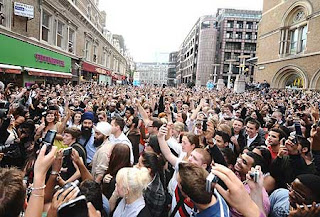Wikipedia definition for "Flash Mob"
A flash mob (or flashmob)[1] is a term coined in 2003 to denote a group of people who assemble suddenly in a public place, perform an unusual and sometimes seemingly pointless act for a brief time, then disperse, often for the purposes of entertainment and/or satire.[2][3] Flash mobs are organized via telecommunications, social media, or viral emails.[4][5][6][7][8][9] The term is generally not applied to events and performances organized for the purposes of politics (such as protests), commercial advertisement, publicity stunts, that involve public relation firms, or paid professionals.[6][10][11]
A flash mob (or flashmob)[1] is a term coined in 2003 to denote a group of people who assemble suddenly in a public place, perform an unusual and sometimes seemingly pointless act for a brief time, then disperse, often for the purposes of entertainment and/or satire.[2][3] Flash mobs are organized via telecommunications, social media, or viral emails.[4][5][6][7][8][9] The term is generally not applied to events and performances organized for the purposes of politics (such as protests), commercial advertisement, publicity stunts, that involve public relation firms, or paid professionals.[6][10][11]
The first flash mob
The first flash mob was created in Manhattan in May 2003, by Bill Wasik, senior editor of Harper's Magazine.[6][9] The first attempt was unsuccessful after the targeted retail store was tipped off about the plan for people to gather.[12] Wasik avoided such problems during the second flash mob, which occurred on June 3, 2003 at Macy's department store, by sending participants to preliminary staging areas – in four prearranged Manhattan bars – where they received further instructions about the ultimate event and location just before the event began.[13]More than 100 people converged upon the ninth floor rug department of the store, gathering around an expensive rug. Anyone approached by a sales assistant was advised to say that the gatherers lived together in a warehouse on the outskirts of New York, that they were shopping for a "love rug", and that they made all their purchase decisions as a group.[14] Subsequently, 200 people flooded the lobby and mezzanine of the Hyatt hotel in synchronized applause for about 15 seconds, and a shoe boutique in SoHo was invaded by participants pretending to be tourists on a bus trip.[9]
Wasik claimed that he created flash mobs as a social experiment designed to poke fun at hipsters and to highlight the cultural atmosphere of conformity and of wanting to be an insider or part of "the next big thing".[9] The Vancouver Sun wrote, "It may have backfired on him... [Wasik] may instead have ended up giving conformity a vehicle that allowed it to appear nonconforming."[15] In another interview he said "the mobs started as a kind of playful social experiment meant to encourage spontaneity and big gatherings to temporarily take over commercial and public areas simply to show that they could".[16]





No comments:
Post a Comment